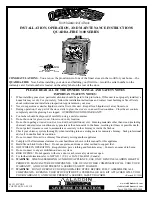
10
SOLID MINERAL FUEL BURNING
Peat is a fuel conveniently available in some areas and should be burned in the same manner as wood.
Fit the two solid fuel burning plates to each side of the fuel grate as shown in Fig. 6.
Before lighting the fire for the first time ensure that the baffle, and the side and back bricks are in position.
Burning without either will result in the stove castings overheating and being damaged.
Open the air wash control and the primary air control fully. Place some tightly rolled paper on top of some
crumpled paper on the base towards the back of the stove. On top of this, place some small pieces of wood
and on top of that a few small pieces of mineral fuel. Light the crumpled paper and close the door. Once the
fire becomes established and the fuel is burning, more fuel can be added. When the stove is hot and the fuel
is no longer producing smoke, the air wash control can be reduced. The burning rate of the fire can be
added. The burning rate of the fire can now be controlled with the primary air control using the stove mitt as
shown in Fig. 5. As air from the primary air control flows up through the grate it will cool the grate bars
preventing them from overheating and becoming damaged. Reducing the primary air control air inlet and
introducing air only from the air wash will allow the fuel to burn but the grate will not be cooled resulting in
damage to the grate bars. When controlling the fire, the primary air control should be altered gradually.
Reducing the primary air dramatically and all at once on a hot stove will cause the fuel to clinker and will
result in a build up of gases and smoke which could ignite with a bang the moment air is reintroduced.
Before adding a large amount of fuel, the grate should be de-ashed and the ash pan emptied. Add the fuel
sloping in from the front coal bar up to the back of the stove to the level of the top of the back brick. Open
the primary air inlet and let the fire burn for a period on high rate in order to get the stove back up to
temperature and drive off the moisture and gases in the fuel. If a lot of smoke is produced on reloading, the
airwash control can be opened further to keep the smoke back from the glass. As the fire gets back up to
temperature, reduce the airwash control and reduce the primary air inlet to suit the burning rate. The exact
setting of the air controls depends on a number of variables including: the flue draught, the fuel used and the
installation and so the best settings for your stove can only be learned by experience.
The level of ash should not be allowed to build up to the level of the grate. If the level of ash becomes too
high the air through the grate will become restricted causing the grate bars to overheat and preventing the
fuel from burning efficiently.
The grate bars in the centre of the stove will wear ore quickly than the ones at the edges. To ensure even
wear, swap the positions of the grate bars occasionally.
Peat
Extended Burning
Ash Removal
Grate Bars
Lighting & Controlling the Fire
11
MAINTENANCE
TECHNICAL INFORMATION
Ordinary bituminous house coal is not recommended and must not be burned in smoke control areas.
Burning bituminous house coal will result in a sooty stove and chimney, and the stove glass will require
cleaning regularly. There are numerous natural anthracites and manufactured smokeless that will burn
cleanly and have more reliable burning characteristics. A list of these fuels and their suitability is produced by
HETAS (www.hetas.co.uk). Consult your local fuel merchant to find out what is available in your area. Petro-
coke should not be used as it burns very hot and may damage the stove castings.
The stove should only be cleaned when it is cold. The exterior can be dusted with a firm brush. Do not use a
cloth, as this will drag on the paint finish leaving lint on the surface. From time to it may be necessary to
renovate the exterior by repainting. High temperature stove paints in aerosol form are available from your
stove dealer. Do not use this form of paint until the stove is cold and always read the instructions on the
container before starting to paint. The door glass is made of a special heat resisting ceramic and may be
cleaned when cold with proprietary glass cleaning liquids and a dry cloth.
The following procedure should be followed if the stove is not to be used for a long period, summertime for
instance. Remove all the ashes from the grate and ash pan and use a vacuum cleaner nozzle to clean ash
from the base of the stove. Remove the baffle plate and brush the flue ways. Close the door and open the air
inlets fully. This action will allow air circulation through the flue ways and help to avoid corrosion and
condensation.
Regular maintenance should be carried out by a competent engineer.
Normal heat output – wood
Normal heat output – solid mineral fuel
5.0 kW
4.5 kW
Weight of stove
83.6 kg
Minimum chimney draught
10 Pa
Mean flue gas temperature – wood
Mean flue gas temperature – solid mineral fuel
244 ºC
235 ºC
Flue gas mass flow – wood
Flue gas mass flow – solid mineral fuel
3.1 g/s
3.6 g/s
This appliance is not suitable for installation in a shared flue system.
Cleaning the Stove
Shutting Down the Stove (Long Term)
Servicing
Mineral Fuels
Your stove should not be used as an incinerator and only recommended fuels shall be
used.
























